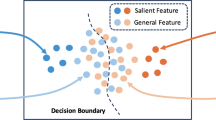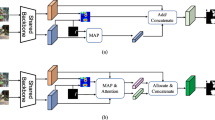Abstract
Few-shot segmentation has recently attracted much attention due to its effectiveness in segmenting unseen object classes using a few annotated images. Many existing methods employ a global prototype generated by global average pooling (GAP) to preserve general support information. However, a single prototype inevitably creates ambiguity due to its limited representation capability. In order to alleviate this problem, we explore hierarchical prototypes for few-shot segmentation in this paper. Specifically, we propose feature interaction clustering (FIC) to extract local prototypes to contain detailed support information, fully mining the relationships among support features, prototypes, and query features. In addition, to compare query features with multiple prototypes, we propose a simple but effective prototype attention module (PAM) that fuses support information from different prototypes. Our method enhances the robustness of the prototypes and improves the utilization of support information. Extensive experiments on common datasets (PASCAL-\(5^i\) and COCO-\(20^i\)) demonstrate the effectiveness of our method.
This work is supported by National Natural Science Foundation of China, No.61771322, No.61971290 and Shenzhen foundation for basic research JCYJ20190808160815125.
Access this chapter
Tax calculation will be finalised at checkout
Purchases are for personal use only
Similar content being viewed by others
References
Boudiaf, M., Kervadec, H., Masud, Z.I., Piantanida, P., Ben Ayed, I., Dolz, J.: Few-shot segmentation without meta-learning: a good transductive inference is all you need? In: Proceedings of the IEEE/CVF Conference on Computer Vision and Pattern Recognition, pp. 13979–13988 (2021)
Chen, L.C., Zhu, Y., Papandreou, G., Schroff, F., Adam, H.: Encoder-decoder with atrous separable convolution for semantic image segmentation. In: Proceedings of the European Conference on Computer Vision (ECCV), pp. 801–818 (2018)
Dong, N., Xing, E.P.: Few-shot semantic segmentation with prototype learning. In: BMVC, vol. 3 (2018)
Finn, C., Abbeel, P., Levine, S.: Model-agnostic meta-learning for fast adaptation of deep networks. In: International conference on machine learning, pp. 1126–1135. PMLR (2017)
Garcia, V., Bruna, J.: Few-shot learning with graph neural networks. arXiv preprint arXiv:1711.04043 (2017)
He, K., Zhang, X., Ren, S., Sun, J.: Deep residual learning for image recognition. In: Proceedings of the IEEE Conference on Computer Vision and Pattern Recognition, pp. 770–778 (2016)
Hu, T., Yang, P., Zhang, C., Yu, G., Mu, Y., Snoek, C.G.: Attention-based multi-context guiding for few-shot semantic segmentation. In: Proceedings of the AAAI Conference on Artificial Intelligence, vol. 33, pp. 8441–8448 (2019)
Li, G., Jampani, V., Sevilla-Lara, L., Sun, D., Kim, J., Kim, J.: Adaptive prototype learning and allocation for few-shot segmentation. In: Proceedings of the IEEE/CVF Conference on Computer Vision and Pattern Recognition, pp. 8334–8343 (2021)
Liu, B., Jiao, J., Ye, Q.: Harmonic feature activation for few-shot semantic segmentation. IEEE Trans. Image Process. 30, 3142–3153 (2021)
Liu, W., Zhang, C., Lin, G., Liu, F.: CRNet: cross-reference networks for few-shot segmentation. In: Proceedings of the IEEE/CVF Conference on Computer Vision and Pattern Recognition, pp. 4165–4173 (2020)
Liu, Y., Zhang, X., Zhang, S., He, X.: Part-aware prototype network for few-shot semantic segmentation. In: Vedaldi, A., Bischof, H., Brox, T., Frahm, J.-M. (eds.) ECCV 2020. LNCS, vol. 12354, pp. 142–158. Springer, Cham (2020). https://doi.org/10.1007/978-3-030-58545-7_9
Long, J., Shelhamer, E., Darrell, T.: Fully convolutional networks for semantic segmentation. In: Proceedings of the IEEE Conference on Computer Vision and Pattern Recognition, pp. 3431–3440 (2015)
Mehta, S., Rastegari, M., Caspi, A., Shapiro, L., Hajishirzi, H.: ESPNet: efficient spatial pyramid of dilated convolutions for semantic segmentation. In: Proceedings of the European Conference on Computer Vision (ECCV), pp. 552–568 (2018)
Nguyen, K., Todorovic, S.: Feature weighting and boosting for few-shot segmentation. In: Proceedings of the IEEE/CVF International Conference on Computer Vision, pp. 622–631 (2019)
Ravi, S., Larochelle, H.: Optimization as a model for few-shot learning (2016)
Rusu, A.A., et al.: Meta-learning with latent embedding optimization. arXiv preprint arXiv:1807.05960 (2018)
Shaban, A., Bansal, S., Liu, Z., Essa, I., Boots, B.: One-shot learning for semantic segmentation. arXiv preprint arXiv:1709.03410 (2017)
Siam, M., Oreshkin, B.N., Jagersand, M.: AMP: adaptive masked proxies for few-shot segmentation. In: Proceedings of the IEEE/CVF International Conference on Computer Vision, pp. 5249–5258 (2019)
Snell, J., Swersky, K., Zemel, R.: Prototypical networks for few-shot learning. In: Advances in Neural Information Processing Systems, vol. 30 (2017)
Sung, F., Yang, Y., Zhang, L., Xiang, T., Torr, P.H., Hospedales, T.M.: Learning to compare: relation network for few-shot learning. In: Proceedings of the IEEE Conference on Computer Vision and Pattern Recognition, pp. 1199–1208 (2018)
Tavera, A., Cermelli, F., Masone, C., Caputo, B.: Pixel-by-pixel cross-domain alignment for few-shot semantic segmentation. In: Proceedings of the IEEE/CVF Winter Conference on Applications of Computer Vision, pp. 1626–1635 (2022)
Tian, Z., Zhao, H., Shu, M., Yang, Z., Li, R., Jia, J.: Prior guided feature enrichment network for few-shot segmentation. IEEE Trans. Pattern Anal. Mach. Intell. 44, 1050–1065 (2020)
Vinyals, O., et al.: Matching networks for one shot learning. In: Advances in Neural Information Processing Systems, vol. 29 (2016)
Wang, H., Zhang, X., Hu, Y., Yang, Y., Cao, X., Zhen, X.: Few-shot semantic segmentation with democratic attention networks. In: Vedaldi, A., Bischof, H., Brox, T., Frahm, J.-M. (eds.) ECCV 2020. LNCS, vol. 12358, pp. 730–746. Springer, Cham (2020). https://doi.org/10.1007/978-3-030-58601-0_43
Wang, K., Liew, J.H., Zou, Y., Zhou, D., Feng, J.: PANet: few-shot image semantic segmentation with prototype alignment. In: Proceedings of the IEEE/CVF International Conference on Computer Vision, pp. 9197–9206 (2019)
Wang, Y.-X., Hebert, M.: Learning to learn: model regression networks for easy small sample learning. In: Leibe, B., Matas, J., Sebe, N., Welling, M. (eds.) ECCV 2016. LNCS, vol. 9910, pp. 616–634. Springer, Cham (2016). https://doi.org/10.1007/978-3-319-46466-4_37
Wu, Z., Shi, X., Lin, G., Cai, J.: Learning meta-class memory for few-shot semantic segmentation. In: Proceedings of the IEEE/CVF International Conference on Computer Vision, pp. 517–526 (2021)
Yang, B., Liu, C., Li, B., Jiao, J., Ye, Q.: Prototype mixture models for few-shot semantic segmentation. In: Vedaldi, A., Bischof, H., Brox, T., Frahm, J.-M. (eds.) ECCV 2020. LNCS, vol. 12353, pp. 763–778. Springer, Cham (2020). https://doi.org/10.1007/978-3-030-58598-3_45
Zhang, B., Xiao, J., Qin, T.: Self-guided and cross-guided learning for few-shot segmentation. In: Proceedings of the IEEE/CVF Conference on Computer Vision and Pattern Recognition, pp. 8312–8321 (2021)
Zhang, C., Lin, G., Liu, F., Yao, R., Shen, C.: CANet: class-agnostic segmentation networks with iterative refinement and attentive few-shot learning. In: Proceedings of the IEEE/CVF Conference on Computer Vision and Pattern Recognition, pp. 5217–5226 (2019)
Zhang, X., Wei, Y., Yang, Y., Huang, T.S.: SG-one: similarity guidance network for one-shot semantic segmentation. IEEE Trans. Cybern. 50(9), 3855–3865 (2020)
Zhao, H., Shi, J., Qi, X., Wang, X., Jia, J.: Pyramid scene parsing network. In: Proceedings of the IEEE Conference on Computer Vision and Pattern Recognition, pp. 2881–2890 (2017)
Author information
Authors and Affiliations
Corresponding author
Editor information
Editors and Affiliations
Rights and permissions
Copyright information
© 2022 The Author(s), under exclusive license to Springer Nature Switzerland AG
About this paper
Cite this paper
Chen, Y., Cao, W. (2022). Exploring Hierarchical Prototypes for Few-Shot Segmentation. In: Fang, L., Povey, D., Zhai, G., Mei, T., Wang, R. (eds) Artificial Intelligence. CICAI 2022. Lecture Notes in Computer Science(), vol 13604. Springer, Cham. https://doi.org/10.1007/978-3-031-20497-5_4
Download citation
DOI: https://doi.org/10.1007/978-3-031-20497-5_4
Published:
Publisher Name: Springer, Cham
Print ISBN: 978-3-031-20496-8
Online ISBN: 978-3-031-20497-5
eBook Packages: Computer ScienceComputer Science (R0)




